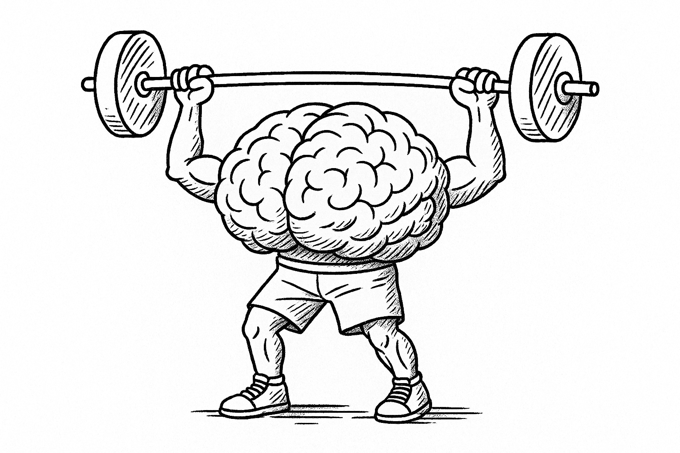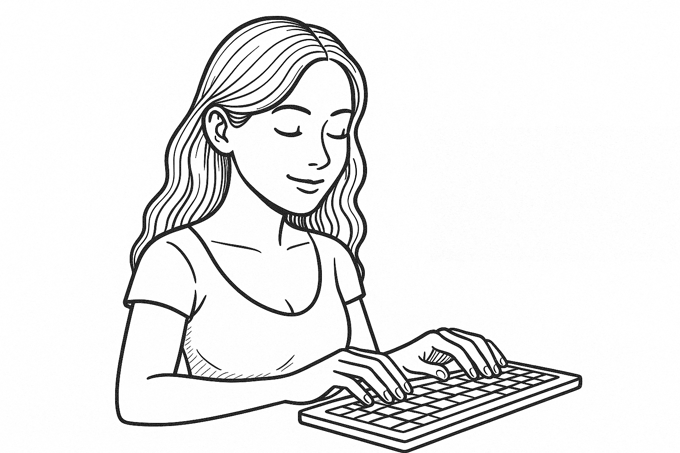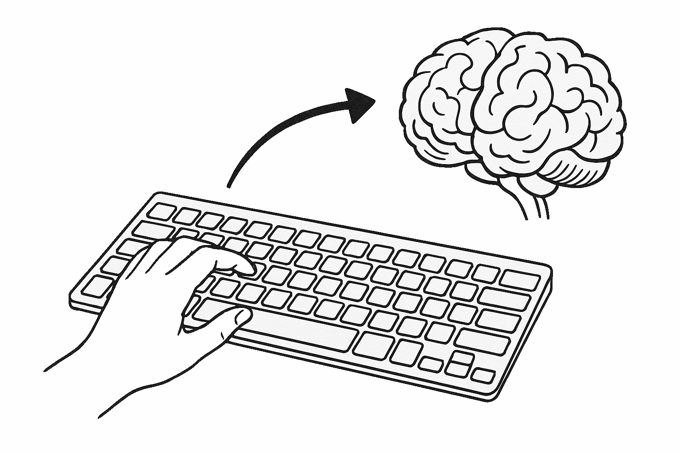Key Takeaways
- The brain-muscle connection: Muscle memory is a neurological process where repetition allows movements to become automatic, freeing up your conscious mind.
- Accuracy creates speed: Prioritizing correct finger placement and accuracy establishes the foundation for high speed later on.
- Consistency wins: Short, daily practice sessions (15-30 minutes) are significantly more effective than irregular, long sessions.
- Unlearning is hard: Bad habits (like looking at the keyboard) are difficult to break, so learning correct form from the start is crucial.
Muscle memory
Muscle memory is the process by which the brain and muscles work together to perform a movement automatically after it has been repeated many times. For example, when a person first learns how to ride a bike, it is often difficult to balance and pedal at the same time. As repetition continues, the task becomes easier until eventually it can be performed without the need to concentrate on it. Although it is called "muscle memory," the memory itself is encoded in the brain, particularly within areas responsible for motor control. It is as if the muscles store information, and the more a movement is practiced, the stronger that memory becomes.
You will not learn how to type fast and correctly if you do not train by repeatedly practicing. Muscles have memory, and you force them to remember through repetition. When a movement is repeated over and over again, a long-term muscle memory is created for that task. This is performed without your conscious effort. It is important to press a key with the correct finger because your muscles will remember your actions. If you concentrate only on speed, you will not succeed. It is better to take some time, look at your keyboard when learning, and ensure that you use the right finger. Remember not to confuse your muscles!

How does it work?
Learning movement patterns allows them to be remembered for the rest of your life, like the ability to ride a bike. When you do not practice a given activity for a long time and then go back to it, it will be easier to learn it again. This can be likened to dancing and performing different dance figures. If you have practiced dancing before, it won't be so hard to learn it later again.
Repeating a given activity raises the number of nuclei found in muscle cells. This creates muscle mass. It is an important factor in bodybuilding.
The aspect of movements being remembered by your muscles is important from the point of view of fast typing.
Each movement activates muscle receptors called proprioceptors, which send signals to the central nervous system. The signal describes the current position of the body, the tension of the individual muscles, and the order in which they work. The brain memorizes the entire sequence of these signals by combining them with the specified motion. By repeating the same movement a second, third, fourth, and next time in a row, you do it faster and more efficiently.
Muscle memory is not only important for typing but also for many other activities like sports or playing musical instruments. You can find a more general description in the Wikipedia article.
What does it have to do with touch typing?
In touch typing, you need to use the correct hand and finger placement on the keyboard, known as the "home row," which is the middle row of keys where the fingers are placed in a specific position. By mastering the correct placement of your hands and fingers on the keyboard, you can reduce the amount of movement required to reach other keys and ultimately achieve a smoother and faster typing experience. This is how you train your brain and muscles to get used to proper typing.
Touch typing is not just about speed. It also involves developing proper posture and technique to reduce the risk of developing repetitive strain injuries, such as carpal tunnel syndrome. By sitting up straight with your feet flat on the ground and your wrists slightly elevated above the keyboard, you can avoid slouching, leaning forward, or resting your wrists on the keyboard.
Moreover, typing accurately is even more important than typing quickly. While it's essential to practice typing speed, you should focus on maintaining accuracy and avoiding mistakes. With regular practice, you can gradually increase your speed over time while maintaining your accuracy. Thanks to this, you stress less. You can focus on what you create and not on the process of typing. You are more immersed in the process of creating.

AgileFingers can help you to learn and practice touch typing. As it offers typing exercises and games, learning to type faster is more fun and engaging. Touch typing is a skill that can benefit you for your entire life, whether you're a student, a professional, or just someone who spends a lot of time on a computer.
How long does it take to develop typing muscle memory?
The time required to develop muscle memory for typing depends on several factors, such as your starting skill level, the time you spend practicing, and the quality of your practice sessions. The time will be different for every single person, but sometimes people ask how long it takes to learn touch typing. It is very hard to answer such a stated question and the answer for each individual will probably be wrong. Let's generalize the answer to show more or less how you can progress in achieving your dream typing speed.
- Daily short sessions (15-30 minutes): noticeable progress after 3-4 weeks.
- Moderate sessions (30-60 minutes): more significant improvement after about 2 months.
- Irregular practice: slower and less stable progress.
Consistency is the most important factor. Practicing a little every day is more effective than practicing a lot once in a while. If you can, resolve that you will spend 10-15 minutes daily for a whole year. You will not treat this time as wasted.
Common mistakes when building muscle memory for typing
Learning touch typing requires attention to correct form. Many beginners make mistakes that slow down their progress:
- Using the wrong fingers for certain keys.
- Looking at the keyboard too often instead of trusting memory.
- Typing too fast without focusing on accuracy.
- Poor posture such as slouching or resting wrists on the keyboard.
It is important to slow down, type carefully, and develop correct habits from the start.
Exercises to strengthen muscle memory for typing
Here are some exercises that can help strengthen your typing skills:
- Focus typing: typing single letters or basic words with the correct fingers.
- Copying texts: typing out entire texts.
- Keyboard typing games: using games to make practice fun and effective.
- Memorizing by typing on the keyboard: learning two things at the same time like typing text from language flashcards.
AgileFingers supports all kinds of listed exercises and more. Daily repetition is essential for building strong and lasting muscle memory.
Touch typing and incorrect typing: the difference muscle memory makes
People whose muscle memory is not trained to press the correct key with the correct finger without looking at the keyboard must look down at the keyboard to press each key, slowing them down. Touch typists trust their fingers to find the keys automatically, which offers several benefits:
- Increased speed with less effort.
- Better focus on writing or working.
- Reduced strain on the eyes and neck.
Why bad typing habits are hard to break
When you learn to type using the wrong fingers or by constantly looking at the keyboard, you build incorrect muscle memory. Over time, your muscles and brain remember these wrong movements just as strongly as they would remember the correct ones. Changing these habits later becomes much harder because you must first "unlearn" the wrong patterns before you can build the right ones.
It is similar to trying to correct your posture after years of sitting incorrectly, hunching over a desk, or holding a phone and looking down. That is why it is so important to focus on accuracy and proper technique from the beginning, even if it feels slow at first. Good habits built early will save you time and effort later, making touch typing truly automatic and comfortable.
How to retrain your fingers after bad typing habits
If you have learned to type with poor habits, retraining is possible but requires patience.
- Return to basics with correct finger placement on the middle row of the keyboard.
- Slow down to focus on accuracy.
- Use typing programs like AgileFingers to structurize your learning process.
- Accept temporary slower speeds during relearning.
Over time, correct habits replace old ones, and typing becomes easier and faster.
The role of consistency and daily practice in muscle memory
Consistency is crucial. Practicing every day helps strengthen the brain-muscle connections needed for touch typing.
- Set a regular time for typing practice.
- Focus on accuracy first before speed.
- Track your progress to stay motivated.
- Use different exercises to keep things interesting.
Short, regular sessions are much more effective than rare long ones.

Summary
To teach the muscles a given movement, you need to repeat that movement over and over. Muscle memory is built through consistent practice, where each repetition strengthens the connection between your brain and your fingers. In touch typing, the most important thing is to press the keys with the correct fingers, following the correct hand positioning and posture.
Many people often ask how to type faster, but they often do not realize that speed is a natural result of proper technique. It is better to focus first on the correct usage of the keyboard - pressing the right keys with the correct fingers and maintaining accuracy - rather than rushing to type quickly. When you create correct muscle memory from the beginning, you lay the foundation for a lifetime of fast and effortless typing.
If you use your keyboard correctly, you will program your muscles so that they do not make mistakes, even when typing at high speeds. In time, looking at the keyboard becomes superfluous, and typing becomes a natural, unconscious activity. You can then focus entirely on your ideas, your writing, or your work, without distraction.
Touch typing is a skill that, once mastered, can serve you throughout your life. It saves time, reduces physical strain, and increases confidence and comfort in any task that involves typing on the keyboard. By practicing consistently and building proper muscle memory, you can achieve speed, accuracy, and healthy keyboard typing skills.